 |
 |
|
|
Prism-Thinning Progressive LensesBy Darryl Meister IntroductionThis course will present the fundamental principles of prism-thinning for progressive addition lenses, including a review of prism, progressive lens geometry, and the advantages of prism-thinning. This is a technical, basic level course intended for dispensing opticians, laboratory technicians, and paraoptometric personnel. An understanding of both basic mathematics and basic optics is required. This course will describe the application of prism-thinning for progressive addition lenses to improve cosmetics and comfort. At the end of this course, you should understand the thickness issues associated with progressive lenses, the advantages of using vertical yoked prism, and the various methods of prism-thinning available to labs. The practical implications of dispensing lenses with prism-thinning will also be discussed, including the verification of lenses with prism-thinning and the identification of potential issues for the wearer. This course requires an understanding of basic optical principles and basic mathematics. Understanding PrismA prism is simply a wedge-shaped piece of refracting material. Like a triangle, the thickest edge of the prism is referred to as the base, while the thinnest edge of the prism is referred to as the apex. A prism changes the direction of light without changing its focus. Prism in a spectacle lens is produced when the front surface is no longer parallel to the back surface (that is, one surface is tilted relative to the other). A round spectacle lens blank with prism at the center will be thicker along the edge that is in the direction of the base of the prismatic effect and thinner along the edge that is in the direction of the apex.  Prism is measured in units called prism diopters (abbreviated 'Δ', the delta symbol). Progressive Surface GeometryA progressive addition lens produces a smooth increase in power from distance to near without any lines of demarcation. In order to provide a gradual—or progressive—change in power, the curvature of a progressive lens surface must become increasingly steeper towards the bottom of the lens. This increase in surface curvature, and the additional surface power produced by this higher curvature, is what produces the add power of a progressive lens.  For instance, a progressive lens surface that measures +6.00 D in the distance zone with a lens clock and +8.00 D in the near zone produces an add power of roughly +8.00 - (+6.00) = +2.00 D. Essentially, the steeper curvature in the near zone of the lens is responsible for producing the add power for near vision. Now, this surface geometry has several important consequences for a progressive lens blank:
 A closer inspection of the cross-section of a typical uncut (or round and not yet edged) progressive lens blank reveals that the steeper curvature of the near zone results in a thicker upper edge and a thinner lower edge, resulting in a difference in thickness between the top and bottom edges. This increased thickness might seem a bit counter-productive for a lens designed to improve cosmetics! Many dispensers are already aware of the problems inherent with such a lens blank from past experiences with Executive-style multifocals. The steeper segment curvature of an Executive-style bifocal also creates a thickness differential between the upper and lower edges of the lens. The thinnest point, or minimum thickness, of a progressive lens blank with no (or plano) distance power is located in the near zone at the bottom edge of the blank. If the minimum thickness of the finished progressive lens blank remains at the edge of the lens, which is usually the case for plus distance prescriptions or progressive lenses with higher add powers, the entire lens blank will be thicker than a comparable single vision lens or flat-top bifocal lens of the same power. Progressive lenses with significant minus distance prescriptions, on the other hand, have their minimum thickness near the center of the blank, as a single vision minus lens would. 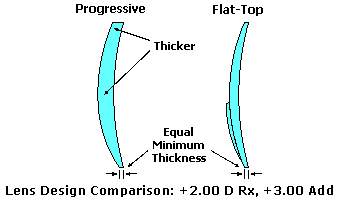 An uncut progressive lens blank made to the same minimum edge thickness as a comparable uncut flat-top bifocal lens blank will be thicker overall, particularly in plus distance powers and higher add powers. Prism-ThinningSo, what can be done to ensure that progressive lens wearers receive the superior cosmetics they expect? How can the excess thickness and weight of progressive lenses be minimized? A process technique known as prism-thinning can be employed to improve the cosmetics of a progressive lens. Prism-thinning (also called equi-thinning) is the process of grinding prism in a progressive lens blank in order to minimize the thickness difference between the top and bottom edges of the lens, as well as to reduce the overall thickness of the lens. Most commonly, prism-thinning typically involves grinding base down prism into a progressive lens. Though, in some cases, base up prism may be appropriate, as we'll discuss later. We say that we are adding base down prism into the lens, but the real objective is to remove base up prism from the lens in order to remove the additional thickness from the top of the lens blank. But how does this work? 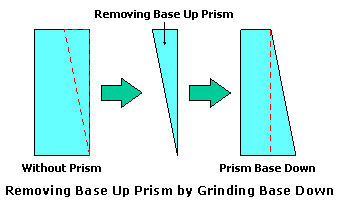 Imagine a block of glass with parallel sides (that is, no prism)... If you remove a wedge of base up prism from the block, the bottom is left thicker. Consequently, the block now has base down prism.  Now consider an actual uncut progressive lens blank. If a wedge of base up prism is removed, the thickness at the top of the blank is reduced. But the finished lens is left with base down prism, since the lens blank initially had no prism. In addition to balancing the thickness difference between the top and bottom of the lens blank, prism-thinning also reduces the center thickness of progressive lenses with a relatively high plus distance prescription or a high add power. This overall reduction in lens thickness also makes the lens lighter in weight. In summary, these features of prism-thinning offer two important wearer benefits:
To avoid creating a vertical prismatic imbalance, the same quantity of vertical prism is ground in both lenses. This type of prism is often referred to as yoked prism, since no net (or binocular) prismatic effect is produced because the vertical prisms are equal. Prism-Thinning CalculationSo how much prism-thinning should be used? A common rule-of-thumb formula provided by some manufacturers to minimize the thickness difference at the top and bottom edges of an uncut progressive lens blank is: Prism = 0.6 × Add This shows that a quantity of base down prism equal to 60% of the add power should be used to slim the lens blank down. Some manufacturers may recommend using 2/3rd the add power (about 67%). These rule-of-thumb approaches are often recommended when the combined distance and add power through the vertical meridian of the lens exceeds +1.50 D or so. For instance, a progressive lens with an add power of +3.00 D might require roughly 2/3 × 3.00 = 2.0 Δ (prism diopters) of base down prism. Note that these rule-of-thumb formulas do not consider factors like the fitting height and the distance power, but still produce satisfactory results in many cases. Ideally, the amount of prism-thinning used should be based upon the following factors:
For instance, lenses with higher plus distance prescriptions may require more prism-thinning. This is also true for progressive lenses with higher add powers. The fitting height is another important factor that should be considered in order to take into account the thickness difference produced by vertical decentration. Lenses with lower fitting heights, for instance, will generally require less prism-thinning in plus powers. Instead of rule-of-thumb formulas, many laboratories use complex computer programs to determine the precise amount of prism-thinning required in order to minimize overall lens thickness. When the prism-thinning is computed in this fashion, the exact amount of prism is determined based upon all of the factors described earlier, including the prescription, frame shape, and fitting information. This method will produce the thinnest and lightest possible lens configuration. Laboratories using this type of software may apply prism-thinning to any progessive lens job, not just jobs with a certain amount of plus power. The add power of the lens is a major factor in determining the amount of prism-thinning required. As the add power increases, the amount of prism-thinning needed in order to equalize the thickness difference and slim the lens blank also increases. 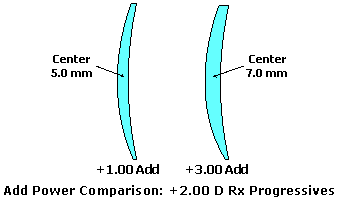 As the add power of a progressive increases, the near zone becomes increasingly steeper. This, in turn, increases the thickness differential between the upper and lower edges, as well as the overall thickness of the lens blank. Prism-Thinning ComparisonNow that we have explored the applications of prism-thinning and the techniques used to compute the optimum amount of prism-thinning, we can review an actual example. Consider a typical progressive lens with a +2.00 D distance Rx and a +2.50 add power, in a frame with a 55 mm eyesize. After performing the necessary computations, a laboratory program might recommend 1.8 Δ of base down prism for this particular job. 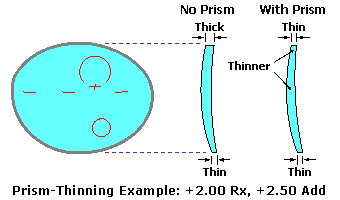 Without prism-thinning, this progressive lens has a center thickness of 4.0 mm, a maximum edge thickness of 3.4 mm, and an overall weight of 7.5 grams. With the application of 1.8 Δ of base down prism-thinning, the same lens now has a 3.3 mm center thickness, a 2.2 mm maximum edge thickness, and a weight of 6.2 grams. Consequently, with the addition of prism-thinning, this progressive lens has become 16% thinner at its center, 34% thinner at its maximum edge, and 17% lighter in weight! The lens is now thinner and lighter in weight, with a more consistent edge profile. Minus LensesWhile prism-thinning often provides substantial benefits for plus powers, it is possible to prism-thin minus-powered lenses, as well. Depending upon the fitting height and the prescription, either base down or base up prism may be required to balance the thickness difference. Although the minimum (or center) thickness of higher-powered minus lenses is not necessarily reduced by prism-thinning, the thickness differential between the upper and lower edges will be, resulting in a more cosmetically balanced edge profile. 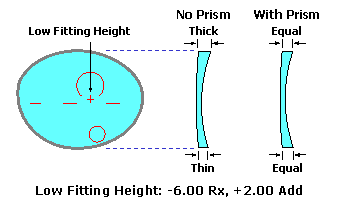 These -6.00 D progressive lenses have a +2.50 D add and a low fitting height. Without prism-thinning, the upper edge of the lens is noticeably thicker than the lower edge. However, with a small amount of base down prism-thinning, the edges are made equal and the lens is more cosmetically and physically balanced.  These -6.00 D progressive lenses have a high fitting height. Without prism-thinning, the upper edge of the lens is noticeably thinner than the lower edge. However, with some base up prism-thinning, the edges are again made equal and more balanced. Wearer AcceptanceSo just how much yoked vertical prism is acceptable? That is, is there a limit to the amount of prism-thinning that a wearer can tolerate? A study was performed a few years ago exploring the effects of vertical yoked prism on wearer acceptance.* This study showed that a group of test subjects was not significantly affected by 2.0 Δ of vertical prism (and no significant postural adjustments were made). However, 4.0 Δ of vertical prism was rejected by almost all of the test subjects. Consequently, the limit of prism-thinning for most wearers will probably lie between 2 to 4 prism diopters. * Sheedy, J. and S. Parsons. "Vertical yoked prism—Patient acceptance and postural adjustment." Journal of Ophthal. Physiol. Opt. Vol. 7 (1987), pp.: 255-257. Aspheric ProgressivesWhile not pertinent to dispensing, it should be noted that certain highly aspheric progressive lenses may not need to be ground with as much—if any—prism-thinning because of the geometry of the progressive surface. The asphericity in the distance zone of such progressive lenses causes the front surface to tilt slightly inside the surfacing blocks used for generating the lens blank, which reduces some of the thickness difference. Some lenses, like the American Optical Omni, are also blocked with shims on the front surface in order to keep the asphericity of the lens surface from causing the lens to rock unpredictably in the surfacing block. While these lenses are automatically produced with a certain amount of prism-thinning, laboratory processing software may still be used to compute the precise amount of additional prism required to achieve optimum results. Prism-Thinning VerificationWe can now address how to verify lenses with prism-thinning. In terms of vertical prism, you are primarily concerned with the net vertical prismatic imbalance between the two lenses at their prism reference points. To calculate the net vertical prism imbalance, either:
The prism reference point is the point on a progressive lens utilized for prism verification. In the absence of prescribed prism, progressive lenses are often surfaced so that the optical center coincides with this point. 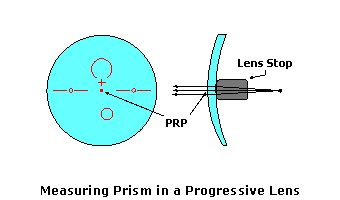 Begin by placing the prism reference point (PRP) of the first lens in front of the center of the lens stop of your focimeter. The prism reference point is centered directly between the two horizontal alignment engravings (or ink markings), usually about 2 to 4 mm below the fitting cross of the lens. 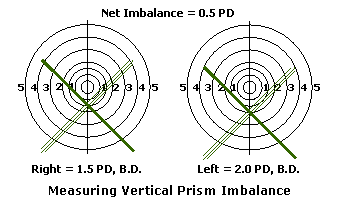 Next, note the amount of vertical prism in the lens. Repeat the procedure for the other lens. Lastly, compare the net difference in vertical prism measurements between the two lenses—that is, the prism imbalance. Any vertical prism imbalance should be compared to the prescribed net vertical prism, if any. Verifying the amount of prism-thinning in a lens is especially important when you are replacing only one of the lenses. If the previous lens had not been prism-thinned and the new one was—or vice versa—an unwanted vertical prism imbalance will be induced. |

